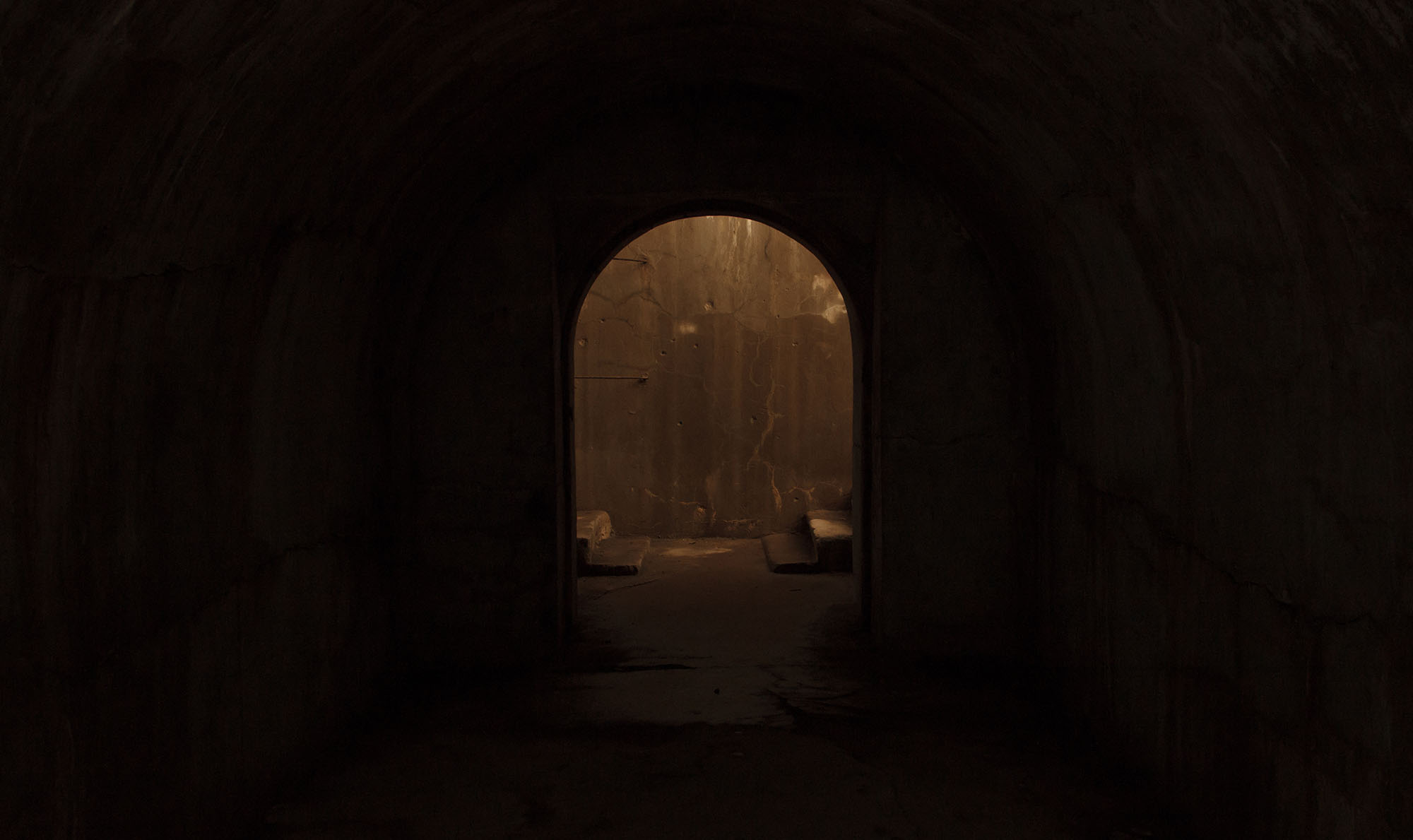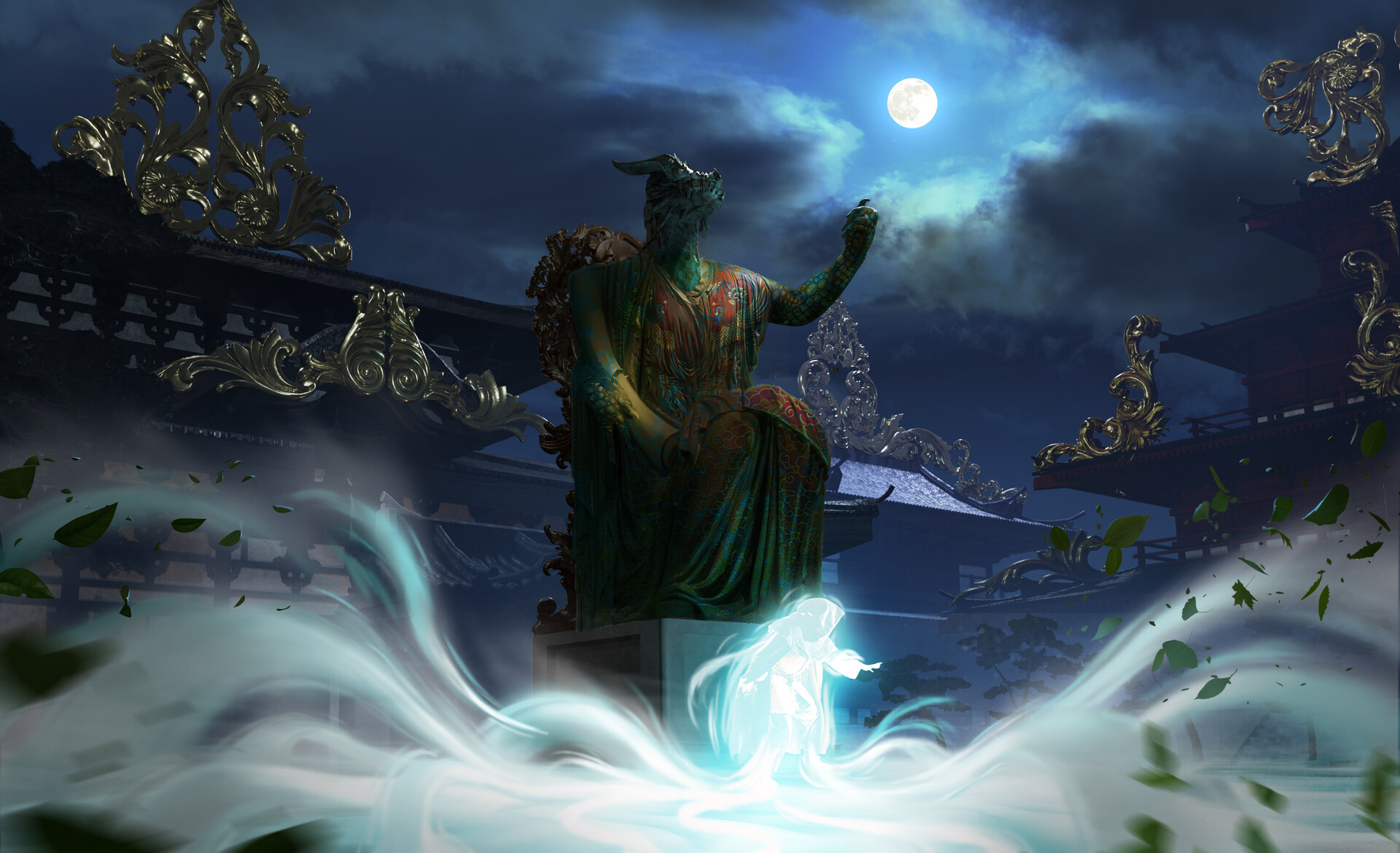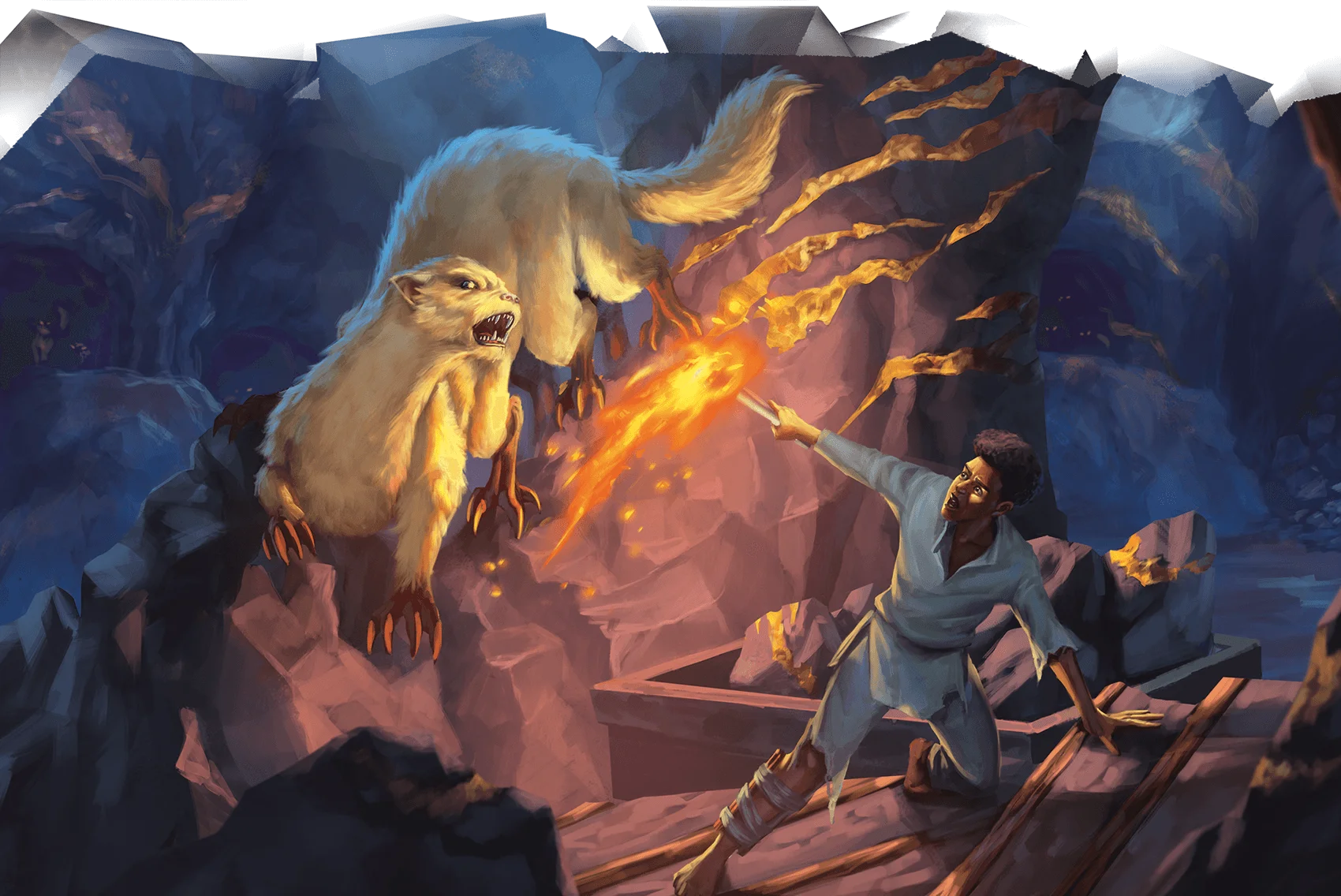After the bombshell report by friend-of-the-show Linda Codega on Wizards of the Coast’s disastrous new version of the Open Gaming License, we discuss the controversy with two guests: Justin Alexander and LegalKimchi. We dive into what the Open Gaming License (OGL) is, its history and context, the legal issues raised by the new document, why no company in their right mind will sign the new license, the reasoning that may be guiding WotC’s decision, and where companies and fans can go from here.
Check This Out – Dungeon Master of None: OG-Hell
Ptolus: Running the Campaign – PC vs. PC Social Checks
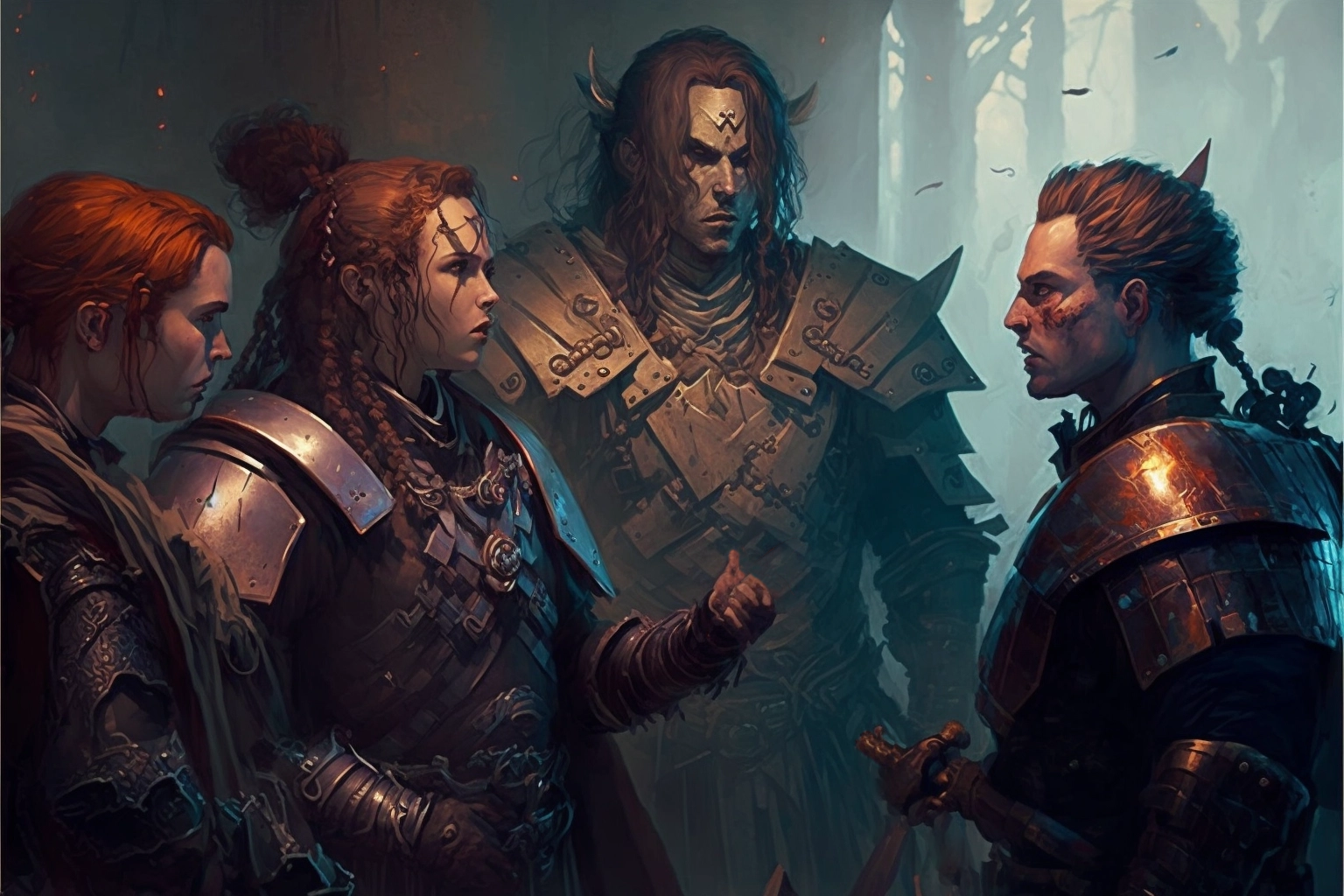
DISCUSSING
In the Shadow of the Spire – Session 31B: Vaults of Forgotten Evil
In the next cave they discovered the creature’s “larder”. A horrible stench permeated the air and the walls were slick with moisture. In a low spot near the center of the cave was assembled a grisly, bloody mess: The partially dismembered corpse of a goblin and a half-devoured corpse, greenish white with bloating and decay, that looked as if it might have once belonged to a man.
Tee was disgusted by the sight and wanted no part of it. But as she turned to leave, Agnarr stopped her. “Aren’t you going to search the cave?”
At this moment during the session, Tee (a PC) decided she was going to lie to Agnarr (another PC).
And I’m guessing that for quite a few GMs reading this, there alarm klaxons blaring.
But this interaction did not, in fact, blow up the entire campaign as the table melted down into tears and recriminations. Instead, it was a lighthearted little moment in which Tee pulled the wool over Agnarr’s eyes, but then the other PCs (who had succeeded on their Sense Motive checks) convinced Tee that she actually should search the bodies. Which, of course, baffled Agnarr, who had been convinced she already had.
Why did this work?
Well, there basically two parts to this.
First, there’s PC vs. PC conflict in general. (Which can be tetchy subject.)
Second, there are social skills aimed at PCs. (Also a tetchy subject.)
Let’s start with PC vs. PC conflict. I’ve found this is often frowned upon and openly banned at many tables. There can be very good reasons for that, but it tends not to be prohibited at my tables. In my experience, tension between the PCs — and even open hostilities — can often result in some of the most memorable and powerful moments at the gaming table.
But it can definitely be problematic. If you want to succeed with PC vs. PC conflict, in my experience, you need a couple of things.
First, and probably most importantly, a group that respects and trusts each other. That includes a healthy understanding that you are not your character, and neither is the other player. (I say “healthy” here because stuff like, “But it’s what my character can do!” seems superficially similar, but is often being used to cover up toxic behavior.)
Second, you have to be willing to lay aside the unspoken presumption that the PCs must go adventuring together just because they’re the PCs.
The problem with this unspoken presumption is that it can very easily turn your gaming session into an improvised production of Sartre’s No Exit: Artificially forcing people together (in this case the characters) who would not logically stay together is to create a living hell. We then try to route around this by layering on even more artificial social rules (e.g., “Thou shalt not conflict with another player character”).
But if you just jettison the presumption, the problems tend to evaporate: The problem is not that Ratface is picking the pockets of Tomlin the Paladin or slitting the throats of prisoners. The problem is that the logical outcome of that action would be Tomlin meting holy justice upon Ratface or, at the very least, expelling Ratface from the group. (Or Tomlin choosing to leave instead.)
(This doesn’t mean that Ratface’s player needs to be expelled from the group. This goes back to a healthy separation of player from character.)
So, long story short, the fact that there’s antagonism and conflict between Tee and Agnarr is not, fundamentally, a problem for this group.
Which brings us to the other side of this, which is a social skill being aimed at the PCs: The idea that Agnarr is being “forced” to believe Tee’s lie.
This sort of thing often results in social skills only being something that PCs are allowed to use on NPCs (and not vice versa). I tend to find that this is throwing the baby out with the bathwater, and I’d rather not have mechanics that can only be used by one set of characters.
This is an issue that I discuss in much greater depth in Rulings in Practice: Social Skills, but in this specific case it mostly just boiled down to the skill check providing Agnarr with information: He believes that Tee is telling him the truth when she says that she searched the bodies. What he chooses to do with that information is ultimately up to the player; the social skill does not dictate action.
As a result, Agnarr’s player was able to take the check as a roleplaying prompt. By taking the mechanics as a cue pointing him in the direction of his character, Agnarr’s player was able to lean into this one and turn it into something ironic and funny for everyone at the table.
Campaign Journal: Session 31C – Running the Campaign: Let It Ride Interrogations
In the Shadow of the Spire: Index
In the Shadow of the Spire – Session 31B: The Vaults of Forgotten Evil

SESSION 31B: THE VAULTS OF FORGOTTEN EVIL
November 9th, 2008
The 17th Day of Kadal in the 790th Year of the Seyrunian Dynasty
WORD ON THE STREET
They decided to head back to the Banewarrens and rejoin Kalerecent’s watch. On their way, however, they passed down Tavern Row. Here they found a dozen ravens perched here and there on various buildings.
“What’s going on?” Tee asked.
“Could it be the Killravens?” Ranthir said.
“I’ll find out,” Elestra said.
While the others continued on, Elestra put her ear to the street. She heard a few people talking about an incident on Tavern Row: The day before, a centaur named Unos, the owner of the Old Goose tavern, had been found murdered in the common room of his tavern at dawn.
Drowning out the affair on Tavern Row, however, were the varied reports surrounding the events at the Cathedral. There seemed to be a good deal of confusion surrounding the exact details. Public opinion was still split fairly evenly on the issue of Rehobath claiming the mantle of the Novarch, but that opinion was beginning to slowly shift in his favor.
THE EMPTY VAULTS
Elestra rejoined the others in the excavated cave outside of the Banewarrens. Kalerecent reported that everything there had been quiet during their absence, and so they headed down to continue their exploration of the farthest vaults.
Passing down a wide hall they came to a T-intersection. The narrower corridor they entered was lined with more than a half dozen of the now familiar warded doors.
One of the doors stood ajar. Inside the chamber beyond this door was a long, metal box, not unlike a lidless coffin. On each of the four corners of the coffin-like receptacle a large amethyst has been inlaid. The inside of the box was lined with six heavy leather straps, arranged in such a way as to bind someone within.
Tee was tempted by the obvious worth of the amethysts, but cautious as well. (They’d already encountered one cursed jewel in this place.) Ranthir examined them closely and determined that the gems had been used to focus several enchantments onto the inhabitant of the box. Some of these appeared similar to those found in a stasis box while others appeared to have some form magical negatement as their purpose.
“Would these enchantments have held Tavan Zith’s abilities in check?” Tee asked.
“Yes, I think so,” Ranthir said. “But they’re harmless now. The spells were broken and the magical energy has dissipated.”
That’s all Tee needed to hear. She pried out the valuable gemstones and dropped them into her bag of holding.
They went back out into the hall. A careful examination of the remaining doors revealed that the wards on one of them had been broken. They opened this door to reveal an empty vault with a large, circular depression in the center of the floor. This depression was filled with water and large patches of the rest of the floor were damp as well.
Tee discovered runes worked into the inner edge of the circular depression and Ranthir was able to identify them as part of enchantments designed to bind something to both the material and ethereal planes. He hypothesized that this chamber might have been used to contain the ethereal-shifting, blue-skinned troll-spawn they had fought before.
THE VAULTS OF FORGOTTEN EVIL
After a brief debate they decided to break open the remaining vaults. Opening the first of these released a blast of chilled air. A large block of ice filled the center of the room, extending from the floor to the ceiling. A careful inspection of this ice revealed that it was laced with thin filigrees of golden thread and Ranthir was able to discern that these threads were minutely etched with tiny runes. Unfortunately, he had no idea what purpose the threads or runes might serve. Large bulbous shadows could be seen within the ice, although making out any sort of detail was quite impossible. When Ranthir was satisfied that he had learned all that he could learn (which was little), he stepped back. Tee started blasting away at the ice using her dragon pistol.
After only a couple of shots, the ice had already cracked badly. Tee lined up her third shot—
—and the ice shattered! A slimy, writhing tentacle burst free. It was followed moments later by more. Tee fired blindly into the ice and then the creatures within were free.
There were three of them – blobs of soft tissue and pulsating gray matter; long tentacles writhing in levitative 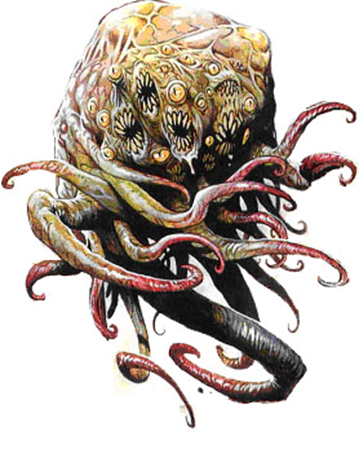 air; numerous, bulbous, yellow, feral eyes and befanged mouths scattered haphazardly within the folds of flabby flesh.
air; numerous, bulbous, yellow, feral eyes and befanged mouths scattered haphazardly within the folds of flabby flesh.
Tor, who had been standing on guard, dashed forward and slashed his sword across the eye of one. Tee, switching her dragon pistol to her side, drew her sword and lunged forward – stabbing through the eye of another and feeling the familiar thrill of it (although this eye was larger than most).
And then Agnarr stepped forward and with a single mighty swing his flaming greatsword cleaved its way through all three of the creatures in a single blow.
As each died in a deflating, wet heap of protoplasmic flesh, a wave of horrific terror swept across them – but each, in their own fashion, found a way to steel their soul against it.
Elestra, thinking of the wraiths they had fought before, took the time to burn the corpses thoroughly.
THE VAULT OF THE PAIN DEMON
They broke the wards on the next door, finding a vault not dissimilar in character but smaller than the last, with a pillar of ice suspended between floor and ceiling.
From a slightly safer distance, Tee again used her dragon pistol to blast away at the ice. Obviously her shots were disrupting whatever magicks had been laid upon the ice because it was not long before the shadowy form within began to shift and move.
As the ice began to crack, waves of hate-filled pain radiated from it. Grimacing against the pain, Tee continued firing. The demon trapped within finally burst free. Its skin was a glistening ebony. Its eyes were a blood-red crimson. Its mouth was a toothless maw with razored lips. Chains were fused about its wrists, each animate with hatred.
As it came free, Tee fired a shot, but it ricocheted harmlessly off the demon’s chitinous shell. The creature howled and the waves of psychic pain battering them seemed to intensify.
Ranthir recognized the thing: It was a naturally demonic creature. Its chains had been soul-bound to its demonic essence – binding its own pain sympathetically and allowing it to reflect that essence back in the psychic waves which were assaulting all of them (although Ranthir tasted only the edge of it from his relatively safe haven in the hall).
Agnarr and Tor had fallen back before its first assault – the waves of pain overwhelming their minds and the animate chains harrying their defenses – but now they rallied, pushing it farther and farther down the length of the narrow chamber. Step by step the pain demon was forced back.
Agnarr suffered grievous wounds from the chains – the cold pain of them numbing his limbs. And the assault of primal pain was strengthening. Those nearest the creature could feel it now as both a psychic and physical thing. The manifestation of pain itself was intense enough to open cuts upon their bodies.
In the end, they were able to beat the creature down.
Tor was left with a single, dramatic cut upon his cheek… But Agnarr welcomed the warming touch of Dominic’s healing.
THE CHITTERING SWARM
The next few vaults proved to be empty. There were no signs that they had even been used.
But then they unleashed the demon swarm.
As the ice of this third vault shattered, the chittering creatures boiled out. Agnarr and Tor had held the chokepoint of the door, but it mattered little as the creatures swarmed around them in every direction.
They found it difficult to fight the swarm. There was a pervasive aura around the dozens of demonlings that seemed to muddle their minds and the tiny creatures would hop from place to place, crawling over them and slipping into their clothes and armor. Some even tried to pry their way into mouths.
Tee fired several blasts ineffectively into the carpet-like mass of demonlings and then fell back before their indomitable advance. The party, in general, split awkwardly in two – with some retreating one way down the hall and others retreating in the other.
The creatures, despite their small size, had vicious claws that ripped and tore as they leaped and scuttled here and there in a chaotic, eddying swirl of motion. And the party discovered, to their horror and disgust, that the creatures were exuding some sort of unnatural black thread – iron-like in strength and binding to the wounds they dealt. The demonlings were literally stitching their limbs together.
Seeaeti howled in pain. Dominic quickly found himself mobbed by the creatures and rendered almost immobile within a cocoon of their black thread.
Ranthir poured flame from his hands and this had some limited success, but still the creatures came. Elestra called down bolts of lightning from thin air, but the demonlings seemed to dance around the scorching blasts.
They were going to be overwhelmed.
“Run!” Ranthir cried.
Elestra did. The others dived for cover.
A bead of fire flew from the tip of Ranthir’s finger into the midst of the chittering swarm. It blossomed into a ball of flame…
And in its wake were left the charred and stinking corpses of the demonlings.
Agnarr stepped forward and put the last of the little fiends out of their well-deserved misery.
This, however, still left them with the difficult task of undoing the demonic, black thread that had been sewn randomly across their bodies. Tee tried to simply rip her way free, but this opened some grievous wounds that sent black spots dancing across her vision.
They started carefully cutting each other free of the stuff. Only Elestra seriously botched this procedure, ripping a gaping wound in Dominic’s side. (The others dissuaded her from helping them with their own extrications.)
THE ABANDONED CAVES
They had now explored this entire section of the Banewarrens and made it as secure as they could (largely by killing everything in sight). Without passing through the sealed door, there was nothing else for them to do here. And so they were left with waiting for the emergence of whatever creature had slipped through the door before Kalerecent had shut it.
They decided to complete their explorations of the caves in which they had fought the umber hulk. Some of them were anticipating the possibility that the creature had returned (affording them with an opportunity to finish it off), and although others were skeptical that it would, if nothing else, eliminate the possibility of a second, unknown entrance to the Banewarrens.
It was an easy matter to return to the caves. Pushing farther into their depths, the group spotted a second passage that had been concealed by a boulder. A little distance further on, Tee saw that the passage they were in opened up into a larger chamber and that, out of that chamber, a second passage appeared to turn in the same direction as the concealed passage behind the boulder.
“Why would it put these boulders everywhere?” Elestra asked.
“I don’t know,” Tee said. But she decided to head down into the larger chamber to see if it did, in fact, meet up with the concealed passage in the way that it appeared to…
And narrowly avoided falling into a pit of loose gravel as it suddenly gave way beneath her feet.
From that they concluded that these boulder-hidden passages had been used by the umber hulk to bypass the traps and snares that it had laid out for the unwary.
With grunts of exertion, Tor and Agnarr managed to leverage the boulder out of the way and they headed down the passage it had concealed.
In the twisting passages beyond they found what appeared to be the creature’s lair: A large bed of stone had been crudely constructed in one corner of a cave in which other stones had been arranged and shaped towards some strange purpose.
“Could it be some form of art?” Ranthir said.
Tee briefly considered the possibility of taking this “umber hulk statuary” and selling it, but she eventually decided that there was unlikely to be any sort of meaningful market for it. Certainly no market worth hauling around several tons of stone for. “I might be able to hustle it… But it’s just not worth the effort.”
Hidden behind some cleverly arranged stones in another corner of the cave they found a surprisingly rich stash of gemstones and gold.
In the next cave they discovered the creature’s “larder”. A horrible stench permeated the air and the walls were slick with moisture. In a low spot near the center of the cave was assembled a grisly, bloody mess: The partially dismembered corpse of a goblin and a half-devoured corpse, greenish white with bloating and decay, that looked as if it might have once belonged to a man.
Tee was disgusted by the sight and wanted no part of it. But as she turned to leave, Agnarr stopped her. “Aren’t you going to search the cave?”
Tee bluffed him into thinking that she had already searched the bodies, but the others eventually convinced her that she should.
“There might be some sort of identification,” Elestra pointed out. “We could let people know what happened to him.”
Tee sighed and started searching.
“Wait,” Agnarr said. “I thought she already searched them?”
“I’m just making sure I didn’t miss anything.”
“Oh. Okay.”
There were no identification papers, but the man was carrying a small coin purse drenched in sickly decay. Tee left it where it lay.
Running the Campaign: PC vs. PC Social Checks – Campaign Journal: Session 31C
In the Shadow of the Spire: Index
Video: A History of the Open Gaming License
Youtube is back bay-beeeee….
This video almost never got released, but patrons of the Alexandrian made me reconsider. You can also read the original essay (which was actually adapted from the script for this video) if you’d prefer.
We also have more videos in the editing pipeline, so I hope you’ll join me in crossing our fingers for more cool Alexandrian video content.
Review: Radiant Citadel – Part 4
WAGES OF VICE (T.K. Johnson) struggles quite a bit with continuity problems and fragility, with the former also contributing quite a bit to the latter.
There are two major continuity glitches. First, it’s fairly clear that the original premise of the adventure was changed at the eleventh hour. As published, the premise of the adventure is that five years ago the Kings of Coin — who rule the city-state of Zinda — made a deal with a witch named Proud Edun. The witch would use her magic to create the jeli flower, a crop with fantastic commercial value which would make Zinda (and, more importantly, the Kings of Coin) fabulously rich.
In return, the Kings of Coin agreed that their firstborn children would all serve as Proud Edun’s apprentices, learning her magical arts. But Myx Nargis Ruba, one of the Kings of Coin, said, “Hey. What if, instead of doing that, we just murder her?”
And the other Kings of Coin agreed and Proud Edun was murdered.
But there’s enough references scattered around the adventure, that it’s clear the original version of this backstory was that Proud Edun was promised the souls of the children. (If I had to make a wild guess, I would guess this was changed because it was too similar to the premise for “The Fiend of Hollow Mine.”) The problems this creates, however, are mostly ignorable.
The other major continuity glitch, though, is more fundamental. The premise of the adventure is that Proud Edun’s daughter, Kala Mabarin, has shown up to claim revenge by killing the kids who were supposed to be apprenticed to her mother. After the first murder, though, reality in the adventure just kind of bifurcates.
In one half of the adventure, Madame Samira Arah — the newest member of the Kings of Coin who (a) doesn’t know about the original double-cross of Proud Edun and (b) is the commanding officer of the Silent Verse, which is the Kings of Coin’s police force — has warned the Kings of Coin of the danger posed by Kala Mabarin and ordered all of their kids into protective custody.
In the other half of the adventure, however, nobody has warned the Kings of Coin and their kids are just wandering around, attending official functions, and getting openly targeted by Kala Mabarin.
This state of affairs just kind of randomly switches back and forth, depending on whichever scene the PCs happen to be in at the moment. It’s incredibly disorienting and fairly fundamental to the scenario, making it one of those crux points where I find players start checking out because the game world stops feeling real to them.
This is compounded because the core structure of the scenario is simultaneously arbitrary, unintuitive, and deprotagonizing.
The basic hook is that the PCs arrive in Zinda to attend — and I know this is going to shock you — a festival. As soon as they arrive at the festival, which is called the March of Vice, they stumble upon the corpse of Jacopo, Kala’s second target and first victim. They get sucked up into the investigation when Madame Samira arrives on the scene and says, “Outsiders? Sounds useful for a case that reeks of powerful conspiracies.”
I love Madame Samira. She’s a fantastic character. I think she’s the major saving grace of the entire adventure. She is simultaneously outsider and insider, and the more she learns about what 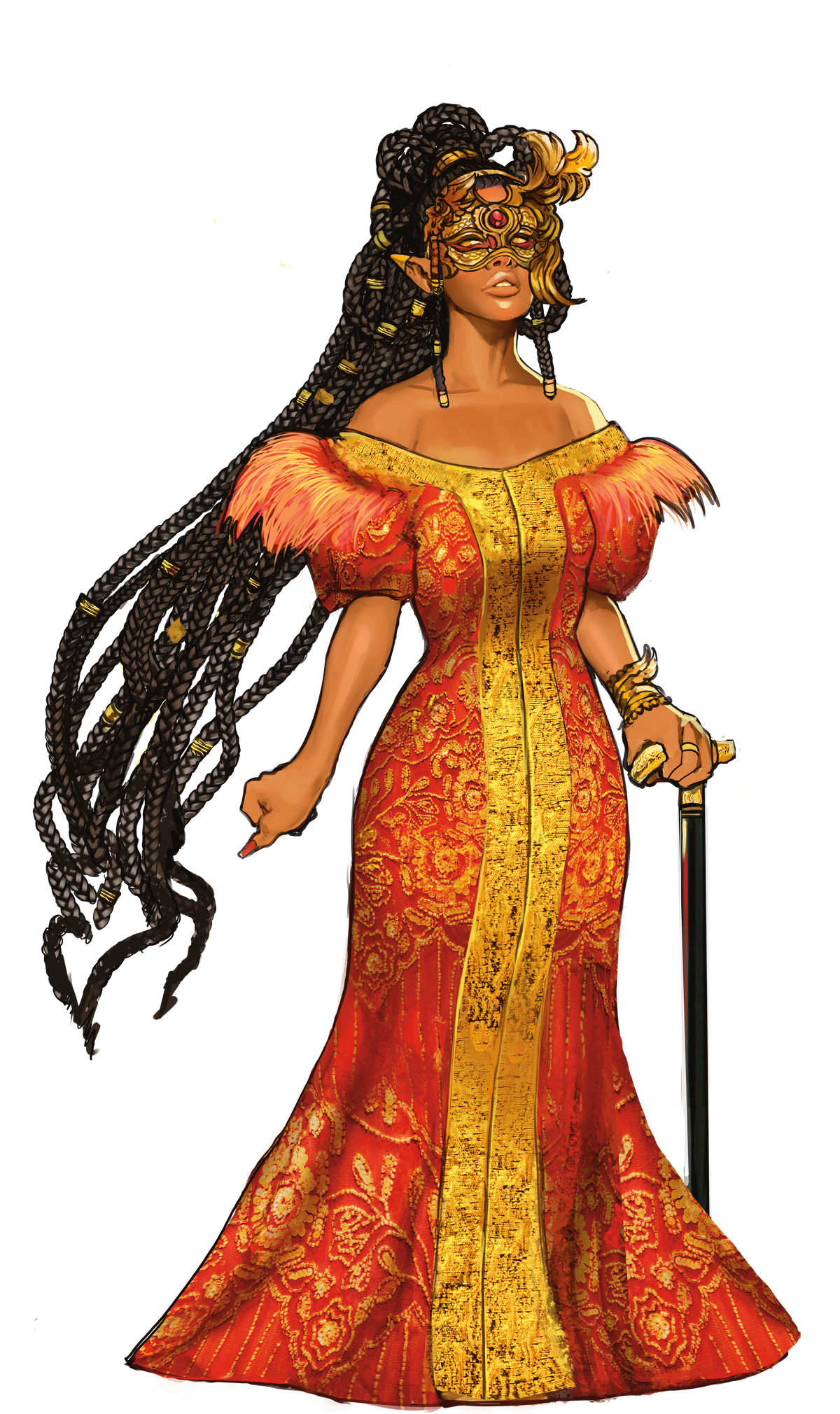 really happened, the more she’s like, “Blackmail over all my political rivals? How fascinating. Tell me more.”
really happened, the more she’s like, “Blackmail over all my political rivals? How fascinating. Tell me more.”
Samira’s own conflict between what’s right and what’s useful adds a delightfully independent vector of ethical haze to a scenario that’s already dripping with moral gray.
From this point, the “investigation” (which can only be loosely described as such) follows a linear path:
- Samira hires the PCs and tells them to go to Thornapple tavern, where they can question Zenia, one of the Coin heirs. Zenia was targeted for assassination yesterday, but escaped, triggering the lockdown.
- On the way to the Thornapple, the PCs coincidentally walk straight into another assassination attempt.
- At the Thornapple, the PCs walk straight into another assassination attempt. (A redo on Zenia.)
- Zenia’s father then confesses that this is all his fault and tells the PCs the whole back story with Proud Edun…
… and this is weird, because he doesn’t actually know that. He has no information identifying the killer as Kala or linking Kala to Proud Edun. (That doesn’t happen until later in the scene and only if (a) the PCs took prisoners and (b) they succeed on a skill check.)
In any case…
- The PCs have absolutely no leads. However, if they’ve learned what Kala looks like (which they easily may not), they can just ask around randomly to see if anyone on the street has seen her. If they do, a random person will tell them, “Yes. She was heading towards the conclusion of the adventure.”
- The PCs can then head to the conclusion of the adventure and walk straight into another assassination attempt, where they can either capture, kill, or negotiate with Kala.
Ultimately, “Wages of Vice” is juggling some really interesting ideas, but doesn’t really manage to pull it off, in my opinion.
Grade: D
Prep Notes: If you’re running this adventure, I recommend prepping a list of the Kings of Coin and their kids. “Okay, so who are the kids being threatened?” is a question the players are very likely to ask. The adventure has this information, but it’s scattered across the text in a very unuseful way.
SINS OF OUR ELDERS (Stephanie Yoon) sees the PCs leave the wine festival in Zinda so that they can head over to the springtime festival of Dan-Nal in Yeonido.
The core cool of Yeonido are the gwishin. Derived from Korean mythology, the dead in Yeonido often rise as undead spirits with unfinished business. This often includes fulfilling unfulfilled duty or correcting imbalance or injustice.
I really love Yoon’s decision to make the gwishin a central pillar of Yeonido as a setting — a haunted city that seeks to draw a veil over their unquiet spirits while discretely making right what they can and appeasing what they cannot. You can frame up an entire campaign with this concept: ghost-hunters settling sins-made-manifest. Virtually any adventure you can imagine can be hung from gwishin hooks with a uniquely supernatural flair: one part Perry Mason, one part Cold Case, one part The Ring.
“Sins of Our Elders” is, of course, itself based around a gwishin mystery. Long ago, the magistrate Dae Won-Ha spent decades doing ??? that resulted in prosperity for Yeonido, but her work was constantly being undermined by Young-Gi, the younger brother of Queen Young-Soo. Young-Gi’s efforts failed, and Won-Ha became a hero of the common people, but also Young-Gi succeeded and Won-Ha became a figure of infamy. Also Young-Gi arranged it so that the credit for whatever it was Won-Ha had done was given to Queen Young-soo. This all happened so long ago that the infamous(?) Won-Ha has passed from living memory, and also so recently that Young-Gi and other people who knew her personally are still alive.
Ten years ago, Queen Young-Soo died and Won-Ha’s gwishin appeared. The PCs need to figure out who the gwishin is, why she’s pissed off, and how she can be appeased.
The core problems of “Sins of Our Elders” mostly have their root in this backstory. It’s vague at best and seemingly contradictory more often than not. The problem is that it’s incredibly difficult to 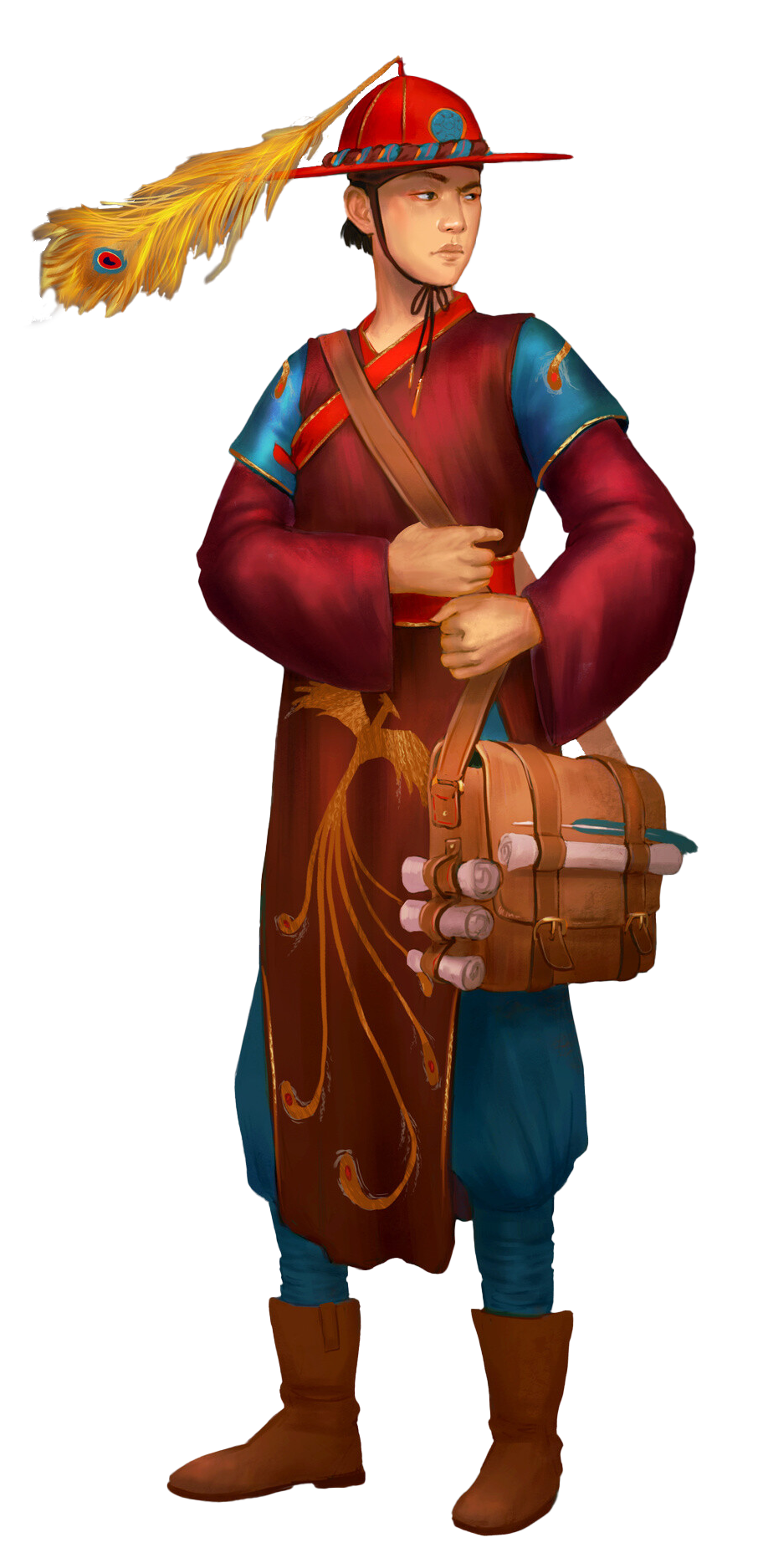 design a coherent mystery when the solution to the mystery hasn’t been defined. It’s like a murder mystery where the solution is “somebody was killed somewhere with some sort of weapon.” You can’t really build clues to reveal the truth if there’s no truth to be revealed, and so “Sins of Our Elders” continually struggles to provide clear clues for Won-Ha’s true legacy because “she did good stuff” doesn’t give you any sort of concrete revelation.
design a coherent mystery when the solution to the mystery hasn’t been defined. It’s like a murder mystery where the solution is “somebody was killed somewhere with some sort of weapon.” You can’t really build clues to reveal the truth if there’s no truth to be revealed, and so “Sins of Our Elders” continually struggles to provide clear clues for Won-Ha’s true legacy because “she did good stuff” doesn’t give you any sort of concrete revelation.
You can see another example of this vague backstory infecting the adventure in the hook. Dae Won-Ha has been taking her revenge on Yeonido in the form of a magical fog. The fog descends on an area, robbing the people there of their memory while Won-Ha wreaks havoc and destruction and terror. Then the people sort of “wake up” in the aftermath, ignorant of everything they did (and that happened in the fog).
This curse is beautifully thematic: The Yeonidons don’t even realize what’s happening to them. It’s a curse of forgetfulness as vengeance for being forgotten.
So, as I mentioned before, this has been going on for ten years when the PCs arrive in Yeonido. The fog doesn’t affect outsiders, so the PCs immediately realize that something weird is—
Hold up.
It’s been ten years and no outsiders have come to Yeonido and noticed the fog in all that time?
At the other end of the adventure, the conclusion is also fatally flawed by the lack of a clear foundation.
Logically, “Sins” is an adventure that would end with the PCs discovering the true story of Dae Won-Ha and then taking action to make sure the truth is known. But there isn’t a true story to discover, so there’s nothing for the PCs to reveal. This forces a conclusion which can be roughly summarized as, “Jeez, Won-Ha. You’re really overreacting. Yes, the Queen and her brother conspired to rewrite the history books and make you look like a villain, but we found a teacup you signed that was gathering dust on a shelf and a couple other trinkets, so it’s not like you’re completely forgotten.”
And then Won-Ha is like, “Yes. You’re right. As long as that teacup is gathering dust, I can rest easy in my grave.”
I really want to like “Sins of Our Elders” because there’s some really cool potential in it, but it just doesn’t quite hold together for me.
I would give the adventure itself a D, but the raw potential of the Yeonido setting gazetteer pulls the whole package up into the C-range.
Grade: C-
Prep Notes: What “Sins of Our Elders” desperately craves is a specificity. A specific truth that happened. A specific lie that was told. One way to achieve that is to make Won-Ha a martyr. This gives you a specific event — the martyrdom — that can be clearly stolen from her.
For a full dose of irony, what if she perished trying to get rid of a powerful gwishin that threatened Yeonida?
Perhaps this could be the gwishin of a dragon, whose grievance with the city was connected to the environmental damage wrought by Yeonido’s expansion. Dae Won-Ha had done much to right those wrongs and bring balance back to the community, but only by offering herself could she quiet this final threat.
This adds a thematic level to the adventure: Dae Won-Ha offered herself to restore balance.
Queen Young-Soo’s version was that she went out into the forest and slew the spirit, setting a tone of violence and conquest which still informs the Tiger District’s expansion into the forest land.
The Truth and Reconciliation at the conclusion of the adventure isn’t just about who gets credit; it’s about understanding the true moral of the story.
If you’re revising the adventure in this way, it shouldn’t be too difficult to bake your new revelation lists into many of the scenes framed in the published adventure. You might also want to change the central structure from “an NPC tells the PCs where they should go to investigate” to a district-based urbancrawl with a handful of sub-revelations (e.g., “Who’s this Young-Gi guy we keep hearing about?”)
GOLD FOR FOOLS AND PRINCES (Dominique Dickey) features the most adorable of the Gygaxian “I think the PCs have too much treasure” metal-eaters — aurumvoraxii.
The adventure is set in the Sensa Empire, where generations ago the aurumvoraxii were hunted to extinction. This has allowed the gold mines of the empire to prosper.
Enter two princes: Prince Kirina and Prince Simbon, both of whom are vying to be named the heir to the imperial throne. Prince Kirina has hatched a scheme which involves triggering a cave-in in the mines while simultaneously summoning aurumvoraxii. After secretly creating the crisis, he’ll head down into the mines and heroically solve it, improving his reputation generally and, most specifically, with the powerful Aurum Guild who oversees the mines. Kirina is, of course, quite unhappy when both Prince Simbon and the PCs stick their noses into the situation.
This is a strong premise for an adventure. The problem, unfortunately, is that it’s executed as a nonsense railroad:
- After some giant scorpions attack, the PCs need to track them back to an alley and make a skill check to find conjuration runes. (Prince Kirina also summoned these scorpions for no reason other than to provide clues revealing his involvement. Which I think is super polite of him.)
- Even though people are dying in the mines, everyone will insist that the PCs go talk to some random scholar about the runes they found. Good news! The scholar is the bad guy working with Kirina. (How lucky!)
- While talking to the scholar, the PCs need to randomly decide to steal some papers off his desk for no reason. If they succeed on a skill check, they do.
- Then they need to make a skill check to analyze the notes, revealing that the scholar is the one who designed the spell that was used to summon the giant scorpions. The PCs will not be allowed to do anything about this.
- The PCs now go down into the mines with Prince Kirina and Prince Simbon. While there, they have to make a Perception check to notice that Kirina has a piece of paper.
- If they succeed on the check and notice the piece of paper, they must now decide to randomly steal it for no reason, requiring a Sleight of Hand check to do so.
- The paper proves that Kirina has a copy of the spell that was used to summon the giant scorpions. The adventure assumes that the PCs won’t do anything about this until they return to the surface, which… uh… have you ever met any PCs?
If I were to write an essay on how to design a mystery scenario (and I have), this would be pretty much exactly how I would tell you to NOT do it.
“Gold” requires:
- Questionable investigation decisions by the players. (For example, just randomly stealing papers from people for no reason.)
- A sequence of 6+ skill checks, missing any one of which completely derails the investigation.
All of which ultimately unlocks a semi-hilarious interaction with Prince Kirina where the PCs make a DC 14 Charisma check to convince him to confess to high treason in front of a huge crowd of people.
There are some ideas here which are potentially interesting, but they’re inchoate to the point where there’s nothing really worth salvaging, in my opinion.
Grade: F
Prep Notes: “Gold for Fools and Princes” is the first adventure in Journeys Through the Radiant Citadel to not feature a festival. But you should totally add one.
The premise of the adventure requires the essential bit of exposition that the aurumvoraxes were wiped out by Emperor Kassa, allowing the gold mines of the Sensa Empire to prosper. But, as written, there’s no way for the PCs to know that until after they’ve identified the aurumvoraxes. So the core revelation of, “Oh no! They’re back!” is handed off to an NPC.
But if you add a Festival of Gold, staged by the Aurum Guild to celebrate the anniversary of Emperor Kassa eradicating the aurumvoraxes, you can slip that bit of exposition in (along with a bunch of other stuff about the importance of the Guild and the mines).
Beyond that, if I were running “Gold,” I would probably strip it down to its core:
- Get rid of the Machiavellian stuff.
- Cave-in opened up a cave that had hibernating aurumvoraxii.
- The two princes are competing for glory, providing a cool roleplaying crux against the challenge of the dungeon.
But to really make it sing, you’ll probably also want to redesign the dungeon to feature encounters that could play strongly into this dynamic. (At a minimum, I’d want the princes to be able to meaningfully split up instead of being stuck on a linear path.)
Archives
Recent Posts
- D&D 5th Edition: Calibrating Your Expectations
- The Vladaam Affair – Part 14C: Crypts of the Brotherhood
- Ptolus: Running the Campaign – Speak With Dead SFX
- In the Shadow of the Spire – Session 46B: Into the Asylum
- The Vladaam Affair – Part 14B: Inner Sanctum
Recent Comments
- on D&D 5th Edition: Calibrating Your Expectations
- on D&D 5th Edition: Calibrating Your Expectations
- on Ex-RPGNet Review: The Speaker in Dreams
- on GM Don’t List #20: Always Say Yes
- on GM Don’t List #20: Always Say Yes
- on Fantasy Names
- on RPGNet and Me
- on D&D 5th Edition: Calibrating Your Expectations
- on Untested 5th Edition: Streamlined Skills
- on D&D 5th Edition: Calibrating Your Expectations


